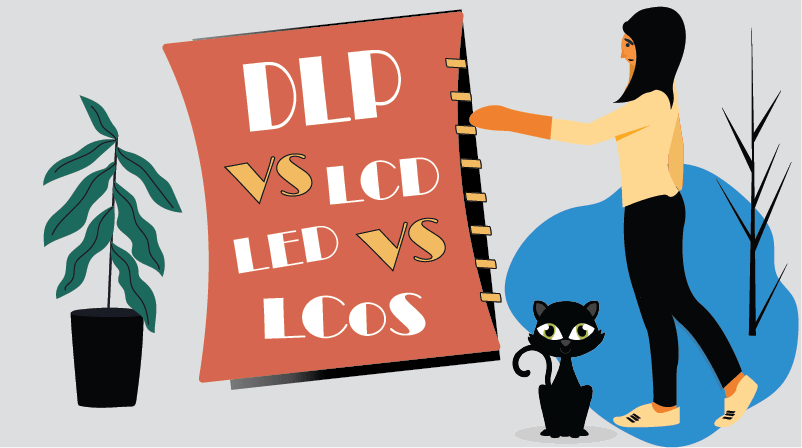Time to learn the significant differences, comparison, and similarities in projector display technology terms like DLP, LCD, LED, and LCoS. I’ll let you know which would be best for you in 2024. So get ready to dive into DLP vs. LCD vs. LED vs. LCoS.

People keep on comparing on google – DLP vs. LCD vs. LED vs. LCoS.
Yes, it is damn confusing.
Projectors’ display technologies are some of the most innovative technologies introduced in recent years. The level of display technology used in projectors undergoes rapid development with every tick of the clock.
The reason is simple. Individuals have diverse needs when it comes to media projection; therefore, it is essential for technology to keep up with these needs.
Are you wondering why the display of a projector is an important technology? However, before we dive into the display, we should understand the types of projectors first.
Projectors are useful in all aspects that require the display of media. You will find them useful in colleges, religious auditoriums, at home, game centers, and other similar places.
It is quite important to know that there are different kinds of projectors that use different display technologies. Understanding the distinct features between the various types will help in making the appropriate choice to suit your display needs.
While some projectors are made for large gatherings, some are made specifically for games and other personal purposes.
The major types of projectors are:
- Digital Light Processing (DLP) Projectors
- Liquid Crystal Display (LCD) Projectors
- Liquid Crystal on Silicon (LCoS) Projectors
- Light-Emitting Diode (LED) Projectors.
There are many fishes in the ocean, but they are in different forms and shapes. Likewise, there are different projectors, but they have distinguishing features that define them and account for their characteristics.
Differences between LED, LCD, DLP, and LCoS
First off, you need to understand these projectors’ individual features to make it easy to pick out their differences.
Are you worried about understanding the specific features of these types of projectors?
There is no need to worry. Specific features, pros, and cons of each type will be evaluated in the latter part of this piece.
But right now, let us evaluate the features that account for their characteristics.
An essential thing to note here is that the significant differences between these projectors are the type and quality of media they produce.
Different projectors produce media with varying quality, using various technologies; thus, they are suitable for different purposes.
However, these differences are a result of some underlying features that are integrated into the projector.
These features include;
Contrast Ratio:
The contrast ratio of a projector is the principal determinant of the image quality. It plays a significant role in the dimension and depth of the output images of any projector.
Contrast ratio is simply the difference between the two extreme pixels; the white and dark pixels. DLP projectors offer the best contrast ratio. This feature accounts for its suitability for home theatres and games.
LCoS comes closely after with an excellent ratio as well. LCD and LED projectors are better for large gatherings.
Color:
Color is an essential aspect of the display. It influences the attractiveness of a projector’s output.
You will only see slight differences in the color of images produced by different projectors.
Different brands, types, and models have their unique color properties. You can always find them written in the manual of the projectors.
Brightness:
The brightness of a projector is otherwise known as lumen ratings. It is the primary determinant of the light output of a projector.
The light output of projectors varies with the model and type of projector. However, on a general evaluation, DLP has the best light output.
However, the modern version of other types of projectors is integrating features to improve their light output.
Rainbow effect:
As the name implies, the rainbow effect helps an image produced by a projector to radiate multi-colored light with a perfect blend.
The technology employs the use of a color wheel. Consequently, DLP has a better rainbow effect than LCoS and LED because it uses a color wheel while the latter does not.
Aside from the listed above, other notable features include motion blur, screen door effect, convergence, and dust resistance.
LCD vs. DLP vs. LED vs. LCoS: The Overview
| Features | LCD | DLP | LED | LCoS |
|---|---|---|---|---|
| Weight | Medium weight | Lightweight | Lightweight | Heavyweight |
| Contrast ratio | Good contrast ratio | Average contrast ratio | Good contrast ratio | Best contrast ratio |
| Pixels burn | Can burn over time | No pixel burn | Unlikely pixel burn | No pixel burn |
| Cost | Medium cost | Most affordable | Medium cost | Most expensive |
| Purpose | Individual use | Large gatherings | Large gatherings | Individual use and large gatherings |
| Light source | LCD | DLP | DLP or LCD | DLP-LCD hybrid |
| Motion Blur | Motion blur issues | Minimal Motion blur | Minimal motion blur | Negligible motion blur |
| Image type | Realistic | Hyper realistic | Realistic | Hyper realistic |
| Overall Image output | Excellent | Good | Good | Excellent |
How Do I Know The Best Projector to Choose?
This question has been a puzzle on the minds of many users and potential buyers. The diverse features of each type of projector make it suitable for different purposes.
Therefore, the real deal is getting a projector that will suit your purpose.
However, now that you know the basic feature of each type of projector, identifying their pros and cons will help you make the best choice.
LED Projector: Hit or Miss?
Pros:
- Long lamp life
- Least expensive to purchase and maintain
- Flexibility with black level, color blur, and motion accuracy
- Efficient energy.
Cons:
- It is not very useful at home or other individual use
LCD Projector: Hit or Miss?
Pros:
- Easy to operate and maintain
- Excellent color accuracy and light output
- Fantastic black levels
- Low power consumption
Cons:
- LCD might have significant issues with motion blur
- A poor or minimal rainbow effect
DLP Projectors: Hit or Miss?
Pros:
- Fantastic color accuracy
- Realistic images
- Suitable for gaming and other individual uses
- Minimal level of motion blur
Cons:
- It has a mirrored chip that limits its number of pixels
- It gives flashes of colors on the screen while trying to give the rainbow effect
LCoS Projectors: Hit or Miss?
Pros:
- Hyper-realistic images
- Little or no chance of pixel bur
- Great motion accuracy
- Fantastic contrast ratio and abundant black levels
Cons:
- It is heavyweight and not portable
- It is relatively expensive
Wrapping Up
The features of the different types of projectors vary just as individual needs vary. Each of these types has its strengths and weaknesses.
LCD, LED, DLP, and LCoS projectors have underlying factors that distinguish between them. These features highlight the differences in their usage and purpose.
Therefore, the choice of an individual is dependent on suitable and desirable features.
Their features, pros, and cons will help you make the best decision to suit your needs by evaluating the differences between the types of projectors.

